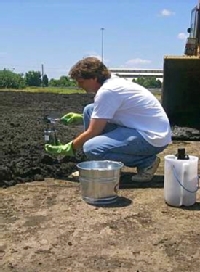VIMS environmental scientists spearhead BDE research in U.S.
In a recent issue of Nature, Dr. Rob Hale, Mark La Guardia, and other colleagues at the Virginia Institute of Marine Science report on their ongoing study of BDEs (brominated diphenyl ethers), a class of environmentally persistent organic pollutants.
BDEs are used in producing flame-retardant material. Currently, North America accounts for 98% of the world’s demand for BDEs. BDEs are structurally related to PCBs and PBBs, which are no longer used in the U.S.
 Hale’s group has detected BDEs in fish, sediments, and sewage sludges. They also detected these pollutants in high concentrations in “biosolids,” sewage sludges used in agriculture, landscaping, and land reclamation. This finding is particularly noteworthy as millions of tons of sludge are recycled in this manner each year and thus the practice may reintroduce BDEs to the environment.
Hale’s group has detected BDEs in fish, sediments, and sewage sludges. They also detected these pollutants in high concentrations in “biosolids,” sewage sludges used in agriculture, landscaping, and land reclamation. This finding is particularly noteworthy as millions of tons of sludge are recycled in this manner each year and thus the practice may reintroduce BDEs to the environment.
The lower brominated BDEs bioaccumulate in wildlife and have begun to be detected in humans. Limited toxicity studies have been conducted to date, mostly in Europe. Results suggest a possible interaction with the endocrine system.
While BDEs have been a concern in Europe for several years and will be banned there in 2003, research in the U.S. is just beginning. According to Hale, “Europeans have been particularly concerned over increasing concentrations of BDEs in human breast milk. We know about some of the effects of PCBs and PBBs. Since these compounds are related, we feel more information on their sources, effects, and fate are needed. In addition, further attention to possible organic contaminants present in landapplied ‘biosolids’ is merited.”
A paper documenting high concentrations of nonylphenols and related detergent-breakdown products in these same sludges, authored by La Guardia, Hale and coworkers, has also recently been accepted in Environmental Science and Technology. These findings further indicate the need to fully examine the chemical constituents of sludge and possible repercussions of their land application.
The papers have been provided to the National Academy of Sciences review panel evaluating the current risk assessment underlying the regulations developed by the U.S. EPA pertaining to biosolids safety.
—Hale, R.C., M.J. LaGuardia, E. Harvey, M.O. Gaylor and W.H. Duff. 2001. Flame retardants: Persistent pollutants in land-applied sludges. Nature 412:141-2.

